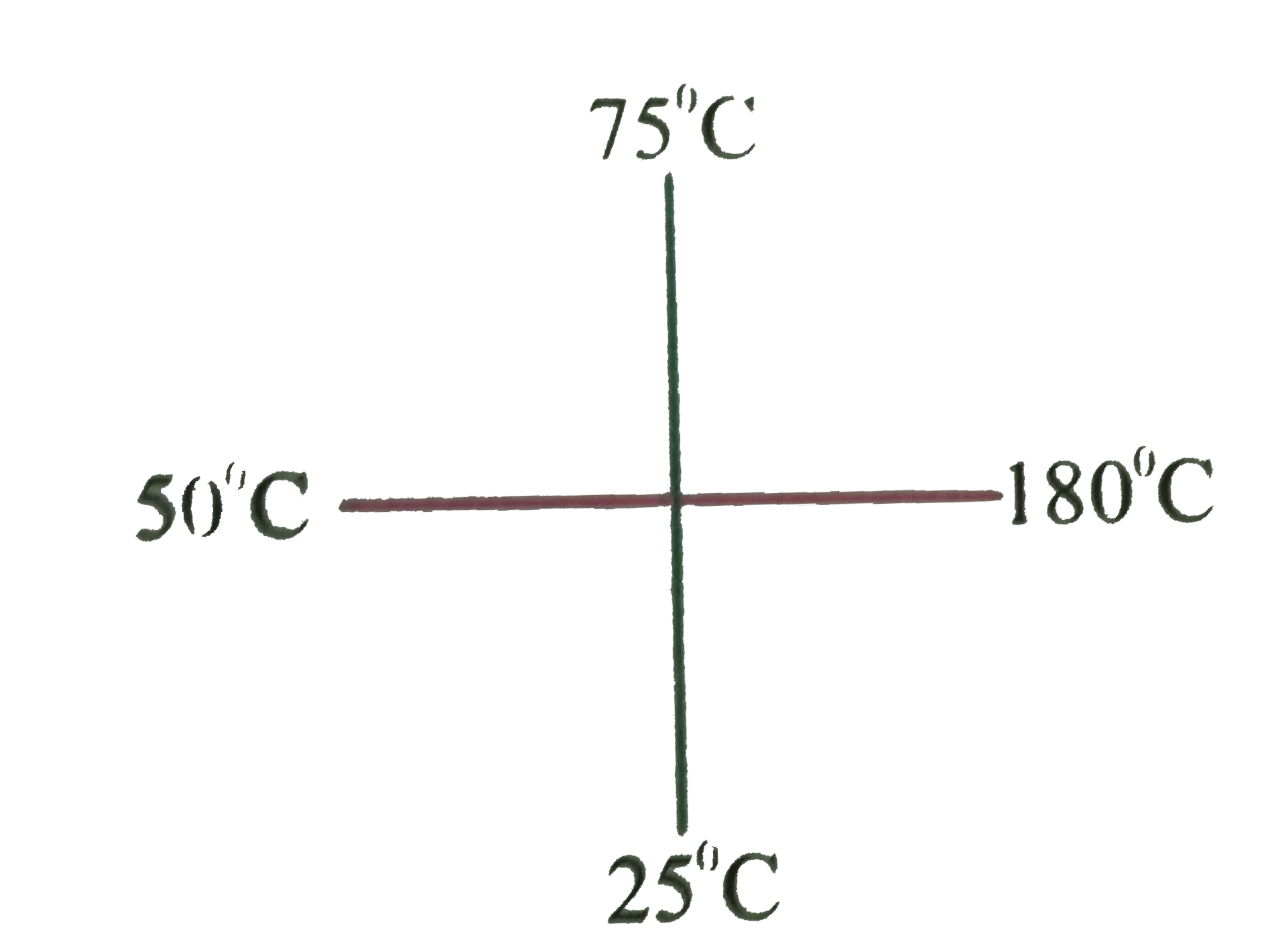Two metal rods made up of iron and brass are of identical shape and size. These are fused at the junction. If the temperature at the free end of iron is at a steam point and brass at ice point then calculate the temperature at the junction, when the steady state is attained. Solution in Kannada
Since
i.e,
i.e.
Hence the temperature of the junction is 315K
Topper's Solved these Questions
- BOOK - SUBHASH PUBLICATIONCHAPTER - THERMAL PROPERTIES OF MATTEREXERCISE - THREE MARKS QUESTIONS AND ANSWERS12videos
THERMAL PROPERTIES OF MATTER
- BOOK - SUBHASH PUBLICATIONCHAPTER - SYSTEMS OF PARTICLES AND ROTATIONAL MOTIONEXERCISE - NUMERICAL WITH SOLUTIONS34videos
SYSTEMS OF PARTICLES AND ROTATIONAL MOTION
- BOOK - SUBHASH PUBLICATIONCHAPTER - THERMODYNAMICSEXERCISE - NUMERICALS WITH SOLUTIONS24videos
THERMODYNAMICS
Similar Questions
Explain anomalous expansion of water
05:42View SolutionA non-uniform bar of weight 'w' is suspended at rest by two strings of negligible weight. The angles made by the strings with the vertical are 36.9∘ and 53.1∘C respectively. The bar is 2m long. Calculate the distance 'd' of the centre of gravity of the bar from its left. (refer fig).-NCERT
 03:03View Solution
03:03View SolutionA refrigerator is used to mainatain eatables kept inside it at 9∘C. If the room temperature is 35∘C, then calculate the coefficient to performance. Calculate the amount of heat rejected to the surrounding.
02:55View SolutionAssume that the thermal conductivity of copper is twice that of aluminium and four times that of brass. Three metal rods made of copper, aluminium and brass are each 15 cm long and 2 cm in diameter. These rods are placed end to end, with aluminium between the other two. The free ends of the copper and brass rods are maintained at 100^@C and 0^@C respectively. The system is allowed to reach the steady state condition. Assume there is no loss of heat anywhere. Under steady state condition the equilibrium temperature of the copper aluminium junction will be
03:04View SolutionThe outer face of a rectangular slab of equal thickness of iron and brass are maintained at 100^(@)C and 0^(@)C , respectively. Find the temperature of the interface. The conductivities of iron and brass are 14 and 126 Wm^(-1) K^(-1) respectively.
01:30View SolutionTwo identical rods are joined at their middle points The ends are maintained at constant temperatures as indicated Find the temperature of the junction
 .08:45View Solution
.08:45View SolutionThe thermal conductivity of copper is four times that of brass. Two rods of copper and brass of same length and cross-section are joined end to end. The free end of copper rod is at 0^(@)C and that of brass rod at 100^(@)C . Calculate the temperature of junction at equilibrium. neglect radiation losses.
02:57View SolutionTwo identical rods are made of different materials whose thermal conductivities are K1andK2. They are placed end to end between two heat reservoirs at temperatures θ1andθ2. The temperature of the junction of the rod is
 06:37View Solution
06:37View Solutionचित्र 11.16 में दर्शाए अनुसार लोहे की किसी छड़ (L1=0.1m,A1=0.02m2,K1=79Wm−1K−1) को किसी पीतल की छड़ (L2=0.1m,A2=0.02m2,K2=109Wm−1K−1) के साथ सिरे से सिरे को मिलाकर डाला गया है | लोहे की छड़ तथा पीतल की छड़ के स्वतंत्र सिरों की क्रमशः 373 K तथा 273 K पर स्थापित किया गया है | (i) दोनों छड़ों की संधि पर ताप, (ii) संयुक्त छड़ की तुल्य ऊष्मा चालकता, तथा (iii) संयुक्त छड़ में ऊष्मा प्रवाह की दर के लिए व्यंजक निकालिए तथा परिकलित कीजिए |
03:59View SolutionTwo rods of copper and brass having the same length and cross - section are joined end to end. The free end of the copper is at 0^(@)C and of brass is at 80^(@)C in steady-state. If thermal conductivity of copper is 4 times of that of brass find the temp. at junction of two rods
08:08View Solutionचित्र में दर्शाए अनुसार लोहे की किसी छड़ (L1=0.1 m ,A1=0.02m2,K1=79Wm−1K−1) को किसी पीतल की छड़ (L2 0.1 m ,A2=0.02m2,K2=109Wm2K−1) के साथ सिरे को मिलाकर ढाला गया है | लोहे की छड़ तथा पीतल की छड़ के स्वतंत्र सिरों को क्रमशः 373 K तथा 273 K पर स्थापित किया गया है |
दोनों छड़ो की संधि पर तापView Solutionलोहे की किसी छड़ (L1=0.1 m ,A1=0.02m2,K1=79Wm−1K−1) को किसी पीतल की छड़ (L2 0.1 m ,A2=0.02m2,K2=109Wm2K−1) के साथ सिरे को मिलाकर ढाला गया है | लोहे की छड़ तथा पीतल की छड़ के स्वतंत्र सिरों को क्रमशः 373 K तथा 273 K पर स्थापित किया गया है |
संयुक्त छड़ की तुल्य ऊष्मा चालकता क्या होगी?07:29View Solutionलोहे की किसी छड़ (L1=0.1 m ,A1=0.02m2,K1=79Wm−1K−1) को किसी पीतल की छड़ (L2 0.1 m ,A2=0.02m2,K2=109Wm2K−1) के साथ सिरे को मिलाकर ढाला गया है | लोहे की छड़ तथा पीतल की छड़ के स्वतंत्र सिरों को क्रमशः 373 K तथा 273 K पर स्थापित किया गया है |
संयुक्त छड़ में ऊष्मा प्रवाह की दर के लिए व्यंजक निकालिए तथा परिकलित कीजिए |05:37View SolutionThere are three iron rods and two brass rods in a compensated pendulum. Coefficients of linear expansion of iron and brass are 12×10−6∘C−1and19×10−6∘C−1 respectively. If the average length of each iron rod is 50 cm, then what is the average length of each brass rod?
View SolutionAn iron bar (L1=0.1m,A1=0.02m2,K1=79Wm−1K−1) and a brass bar (L2=0.1m,A2=0.02m2,K2=109Wm−1K−1) are soldered end to end as shown in fig. the free ends of iron bar and brass bar are maintained at 373 K and 273 K respectively. Obtain expressions for and hence compute (i) the temperature of the junction of the two bars, (ii) the equivalent thermal conductivity of the compound bar and (iii) the heat current through the compound bar.
 .07:39View Solution
.07:39View Solution

